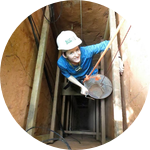About This Project
The environmental costs of fertilizer use in the tropics are understudied. Mato Grosso, Brazil, once an Amazon deforestation hot spot, is expanding Nitrogen fertilizer use for maize production. Fertilizer use can cause NO gas loss (which drives smog and ozone production), and release N2O (a potent greenhouse gas). We will measure these gases at a large commercial farm in Mato Grosso to inform policy in the Amazon region and tropical agriculture.
Ask the Scientists
Join The DiscussionWhat is the context of this research?
Meeting the growing demand for food and livestock feed will require tropical regions to intensify agricultural production. However, the environmental costs of agricultural intensification in the tropics are understudied. Within the tropics, one of the most crucial agricultural regions is Mato Grosso, Brazil. Once an Amazon deforestation hotspot, Mato Grosso now contains a rapidly intensifying agricultural landscape covering ~100,000 km2 (about the size of Kentucky) and is now the world’s second-largest soy producer. Mato Grosso is shifting from single-cropping of soy, a nitrogen (N)-fixing legume, to double-cropping of soy and maize, which requires N fertilizer inputs to highly-weathered tropical soil.
What is the significance of this project?
Nitrogen fertilizer is often necessary to maintain yields, but it can cause significant environmental problems. For example, nitric oxide (NO) gas loss has significant negative consequences for human health and plant productivity (it drives smog and ozone production), and nitrous oxide (N2O) is a potent greenhouse gas (GHG). To date, researchers have measured N2O but not NO emissions from this agricultural region. Measured N2O emissions are much lower than what we would expect given the fertilization inputs. A study from a different tropical, fertilized agriculture site with a similar soil (but in Kenya) found higher NO than N2O emissions, suggesting that measurements of this smog- and ozone-producing gas at Mato Grosso would be highly informative.
What are the goals of the project?
I aim to answer the following questions: How do N2O and NO emissions vary between three land uses (soy, maize, and intact tropical forest)? What impact does irrigation have on N2O and NO emissions in maize fields?
Hypotheses: (H1) N2O and NO emissions will be higher in fertilized maize than in tropical forest and unfertilized soy because of a higher N cycling rate from fertilizer inputs. (H2) Irrigation of fertilized maize will shift N emissions from primarily NO to primarily N2O, lowering oxygen level in soil pores compared to non-irrigated, fertilized maize.
Budget
These are the materials I need to complete my experiment. I have another small grant to cover the cost of travel to the site, but I need to buy these materials to do the study.
Endorsed by
Meet the Team
Affiliates
Alex Huddell
I am a graduate student in Ecology and Evolution at Columbia University. My PhD research focuses on the effects of nitrogen fertilizer on the environment, and measured greenhouse gas fluxes (nitrous oxide), sources of air pollution (nitric oxide and ammonia), and sources of water pollution (nitrate leaching) from agriculture in the tropics and in a perennial wheatgrass.
I'm here to raise funds for a summer research field program focused on environmental justice in Washington Heights, New York City. Some fellow graduate students and I are planning a project to quantifying ecosystem service benefits of increased green infrastructure in Washington Heights and improving access to natural areas and ecosystem quality of (Highbridge park) and natural shoreline (Swindler's Cove).
Additional Information
First, I will go to Brazil this winter to collect the data on N2O and NO emissions. Then I will compare the N2O and NO emissions between the soy, maize, and intact tropical forest plots. If the maize plots are significantly higher than the other two land uses, I will accept the first hypothesis. Then, I will test whether the irrigated plots have higher N2O emissions than non-irrigated plots. If so, I will accept the second hypothesis that irrigation will shift Nitrogen emissions to a greater N2O:NO ratio than non-irrigated plots.
I will disseminate these results in scientific publications and conference presentations. My Brazilian and American collaborators will then communicate these results to Brazilian policymakers and use them to estimate the impacts of fertilizer use in the broader Amazon region and other similar agricultural regions in the tropics.
Project Backers
- 4Backers
- 10%Funded
- $219Total Donations
- $54.75Average Donation

